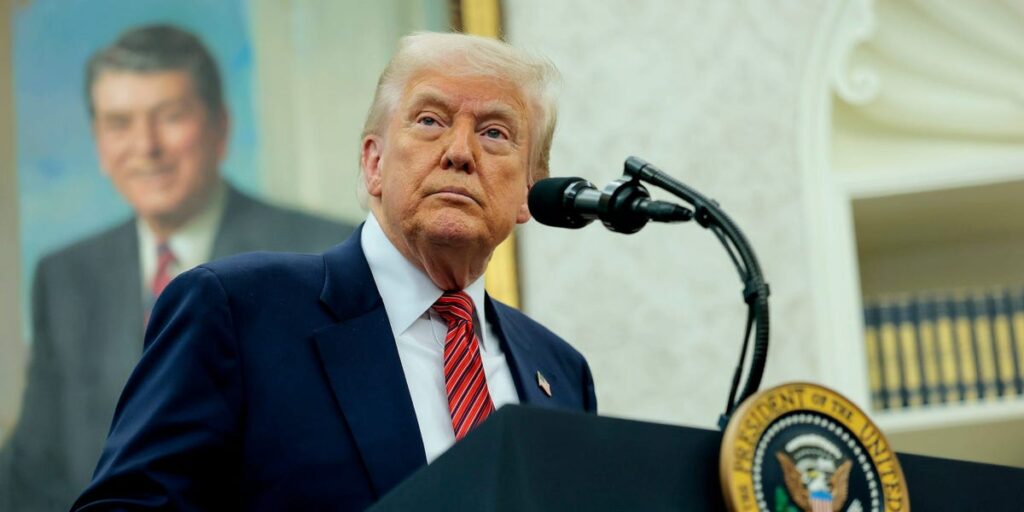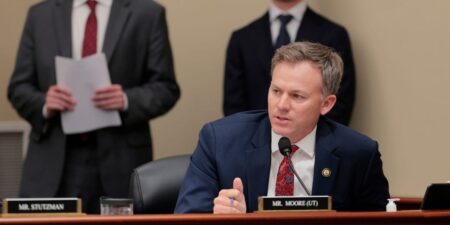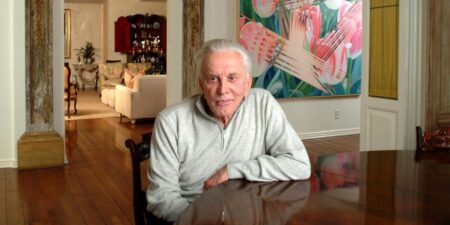X
Copy link
Impact Link
Save
Saved
Read in app
subscribers. Become an Insider
and start reading now.
Have an account? .
- For the past 70 years, Gallup has measured US presidents’ approval ratings.
- Bill Clinton had the highest approval ratings at the time he left the Oval Office.
- Donald Trump’s first-term rating is tied for eighth place with George W. Bush’s and Jimmy Carter’s.
President Donald Trump is seeking to rewrite US immigration policies, has reshaped how world leaders use social media, and has made historic changes to the federal workforce.
But in his first term, he made history in a way he may wish to forget: He was the first president since Gallup began tracking presidential job approval in the 1930s to fail to exceed a 50% approval rating at any point during his term.
In Gallup’s latest poll, conducted during the first half of May, 43% of respondents said they approved of Trump’s performance, down from 47% in polling conducted during the first six days of his second term in January.
In the recent poll, 53% said they disapproved of his handling of the presidency. This number has held steady since March, a month rocked by leaked Signal chats and the economic shake-up of tariff policies. (A handful of people in each poll said they had no opinion of Trump’s job performance.)
For nearly a century, the polls have been used to measure the public’s perception of US presidents’ performance, with Gallup asking Americans: “Do you approve or disapprove of the way [the current president] is handling his job as president?”
The American Presidency Project from the University of California, Santa Barbara, compiled the final Gallup ratings of each president’s term from the past 70 years, signaling how popular each leader was when they left the Oval Office.
See how US presidents from Harry Truman to Joe Biden rank in this end-of-term polling. We’ve ordered them from the lowest approval rating to the highest.
Richard Nixon
Approval rating: 24%
Even though Nixon won the 1972 election in a historic landslide, the end of his presidency was tainted by the Watergate scandal that led him to resign on August 9, 1974, when faced with the threat of an impeachment and removal.
Surveyed August 2 to 5, 1974, after the House Judiciary Committee passed articles of impeachment against the president but before he resigned, 66% of respondents to the Gallup poll said they disapproved of Nixon’s presidency, the highest of any president on the list.
Harry S. Truman
Approval rating: 32%
Assuming the presidency after Franklin D. Roosevelt’s death, Truman served two terms covering the aftermath of World War II and the beginning of the Cold War, including the Korean War, which was widely unpopular and contributed to Truman’s low approval rating by the end of his second term in 1953.
When asked December 11 to 16, 1952, 56% of poll respondents said they disapproved of his handling of the presidency.
Jimmy Carter
Approval rating: 34%
Carter had high approval ratings — and a disapproval rating in the single digits — during the early days of his term, but his handling of international affairs, such as the Iran hostage crisis in 1979, along with a struggling economy, ultimately made him unpopular by the end of his term.
He lost the 1980 election to Ronald Reagan and faced a disapproval rating of 55% in polling conducted December 5 to 8, when he was readying to leave the White House.
George W. Bush
Approval rating: 34%
Despite uniting the nation in the wake of the 9/11 attacks, Bush saw his public approval fade during his second term. His approval rating spiked after the 2001 terrorist attacks, the beginning of the Iraq War in 2003, and the capture of Saddam Hussein.
After his reelection, his popularity began to decline as the Iraq War extended. His handling of Hurricane Katrina in 2005 and the onset of the 2008 financial crisis also contributed to his growing unpopularity.
From January 9 to 11, 2009, as Bush prepared to hand over the presidency to Barack Obama, 61% of poll respondents said they disapproved of his handling of the presidency.
Donald Trump
Approval rating: 34%
Trump’s presidency was divisive from the start, as he entered the White House with an approval rating below 50%. He’s the first president in modern history to never exceed 50% approval on the Gallup polls during his presidency.
While his approval ratings dwindled over the course of his four years in office, his handling of the COVID-19 pandemic in particular came under scrutiny ahead of his loss in the 2020 election. His lowest approval ratings in office came during the final Gallup poll, conducted January 4 to 15, 2021.
Most of that polling period took place immediately after the Capitol insurrection on January 6, and Trump faced a disapproval rating of 62%, the worst after Richard Nixon’s at the time he left the office.
Joe Biden
Approval rating: 40%
While Biden saw continuous approval ratings over 50% during his first six months in office, rises in inflation and illegal immigration, as well as the wars in Ukraine and Gaza, contributed to lowering approval ratings.
His lowest-ranking Gallup poll, in which 36% of respondents said they approved of his handling of the role, came in July 2024, a month after his debate performance against Trump shifted focus toward his age and fitness for office.
As he left office, in polls collected January 2 to 16, 2025, Biden received a disapproval rating of 54%.
Lyndon B. Johnson
Approval rating: 49%
After assuming the presidency because of John F. Kennedy’s assassination, Johnson won the 1964 election in a historic landslide, but he faced decreasing approval ratings over his handling of the Vietnam War.
Low approval ratings, along with a divided party, led Johnson to withdraw from the presidential race in 1968. At the time of his withdrawal, 36% of poll respondents said they approved of his handling of the presidency.
By the time he left the office, however, his ratings had gone up to 49% approval. In polling conducted January 1 to 6, 1969, 37% of respondents said they disapproved of his handling of the role, and 14% said they had no opinion, one of the higher percentages among the listed presidents.
Gerald Ford
Approval rating: 53%
Assuming the presidency at the time of Nixon’s resignation, Ford served as US president from August 1974 until January 1977, after he lost the election to Jimmy Carter.
During his presidency, Ford faced mixed reviews, with his approval dropping after he pardoned Nixon and introduced conditional amnesty for draft dodgers in September 1974.
Polled December 10 to 13, 1976, after he had lost the reelection to Jimmy Carter, 32% of respondents said they disapproved of Ford’s handling of the presidency, and 15% said they had no opinion on it, the highest percentage of the listed presidents.
George H. W. Bush
Approval rating: 56%
Though the elder Bush lost his reelection bid in the 1992 presidential election against Bill Clinton, the public opinion of him was positive by the end of his term.
In the weeks before his nomination as the Republican candidate for the presidency in 1992, however, he had only a 29% approval rating, the lowest of his presidency. A recession and a reversal of his tax policy contributed to his drop in popularity.
In polling conducted January 8 to 11, 1993, 37% of respondents said they disapproved of his handling of the presidency, while 56% said they approved.
Barack Obama
Approval rating: 59%
Since the beginning of his presidency in 2009, Obama had a high approval rating for a modern-day president; he averaged nearly 47% approval over eight years.
At his lowest point, in polling conducted September 8 to 11, 2011, 37% of poll respondents said they approved of his presidency, the decline most likely influenced by the president’s healthcare policies and his handling of the 2008 economic crisis and the following rise in unemployment rates.
In polls conducted January 17 to 19, 2017, when Obama was leaving office, 37% of respondents said they disapproved of his handling of the role, with 59% saying they approved.
Dwight D. Eisenhower
Approval rating: 59%
After winning the 1952 election in a landslide, Eisenhower saw high approval ratings throughout his presidency, never dropping below the disapproval rating.
Holding office during critical Cold War years, Eisenhower saw his stay positive throughout the end of his second term, with only 28% of respondents polled December 8 to 13, 1960, saying they disapproved of his handling of the presidency, the lowest of the presidents listed.
Ronald Reagan
Approval rating: 63%
Reagan’s strong leadership toward ending the Cold War and implementing his economic policies contributed to consistently positive ratings during his presidency and the subsequent election of his vice president, George H. W. Bush, as his successor to the presidency.
By the time he left office, 29% of respondents in a Gallup poll conducted December 27 to 29, 1988, said they disapproved of his handling of the presidency.
Bill Clinton
Approval rating: 66%
After winning the 1992 elections against the incumbent George H. W. Bush, Clinton saw high approval ratings throughout his presidency, though he faced mixed opinions at times during his first term because of his domestic agenda, including tax policy and social issues.
Despite being impeached in 1998 by the House of Representatives over his testimony describing the nature of his relationship with Monica Lewinsky, Clinton continued to see positive approval ratings during his second term.
Near the time he left the White House, he had an approval rating of 66%, the highest of all the presidents on this list. In the poll conducted January 10 to 14, 2001, 29% of respondents said they disapproved of his handling of the presidency.
Read the full article here
















